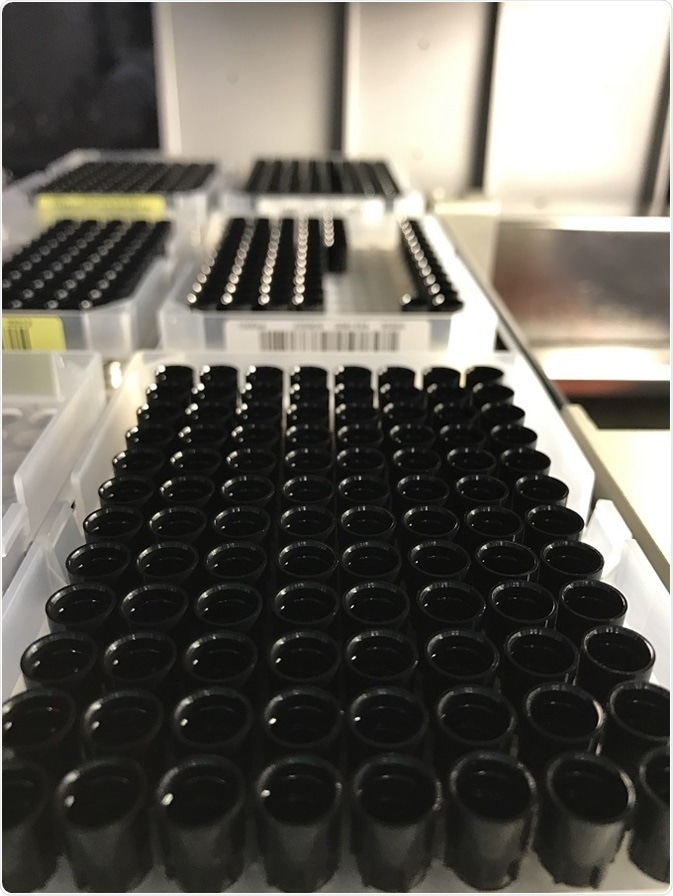Sanger sequencing is a DNA sequencing method developed by Fred Sanger in 1977. The technique is based on incorporation of chain-terminating dideoxynucleotides by DNA polymerase during replication of DNA. This creates DNA chain lengths corresponding to every nucleotide. These sequences can then be separated using polyacrylamide gel electrophoresis.
Sanger sequencing requires a single-stranded DNA template, DNA primers to begin replication, DNA polymerase, deoxynucleotriphosphates to build the chain, and chain-terminating dideoxynucleosidetriphosphates (ddNTPs). Four sequencing reactions are started corresponding to each of the nucleotides present in DNA: adenosine, guanine, cytosine, and thymine.
One of the four chain-terminating dideoxynucleotides is added to each reaction vessel along with the other required materials. DNA replication is initiated, then the reaction vessel is heated, separating the chains, and cooled again so the reaction restarts with fresh primers. The reaction is thermally cycled about thirty-five times, and then the resulting chains are separated side-by-side on a polyacrylamide gel. The result can be “read” from left to right, top to bottom.
Sample preparation
DNA template quality is a critical factor in successful Sanger sequencing. DNA for sequencing is cloned into a plasmid--a circular piece of DNA that can then be used to amplify the template. The sample must be carefully prepared to avoid contamination by genomic DNA, RNA, or other sources of non-template DNA.
Once cloned into a plasmid, the template is amplified by PCR, quantitated, and diluted to the desired concentration for sequencing.
Automation
The Sanger sequencing process can be laborious to carry out by hand. Nowadays, Sanger sequencing is usually automated. Automated sequencing instruments combine sequencing with fluorescently labeled primers or dideoxy chain terminators with polyacrylamide gel electrophoresis and computer data capture.

Credit: mllejules/Shutterstock.com
A robotic arm carries out the pipetting operations and thermal cycling is controlled by a computer. Online detection by laser-induced fluorescence allows the system to read the sequence directly into a software program that can then capture and analyze the sequence.
Capillary electrophoresis
Capillary electrophoresis was a critical development for automated sequencing. It was developed in the 1990s and has replaced slab gels in automated sequencing systems. Instead of a slab, the polyacrylamide matrix fills a glass capillary tube and the DNA solution injected into the capillary. The polyacrylamide solution is then automatically replaced after each run to refresh the system. Capillary sequencing is faster and more sensitive for sequencing. Multiple capillaries were then combined for sequencing in parallel. The preferred format now has 96 capillary columns.
Data analysis
DNA sequencing produces raw data for the fragments in the sample. The fragment sequences are then assembled into longer sequences depending on the nature of the sequencing project. The full sequence could be a gene or an entire genome. Because of the complexity of this analysis, it requires a great deal of computing power. Repetitive sequences can be problematic in assembling larger fragments or full genomes. They may cause inaccuracies when assembling the sequence. There are a number of software analysis packages on the market that work with automated sequencing systems.
Sources
- Sanger, F., & Coulson, A. (1975). A rapid method for determining sequences in DNA by primed synthesis with DNA polymerase. Journal of Molecular Biology,94(3), 441-448. doi:10.1016/0022-2836(75)90213-2
- Automated Sanger dideoxy sequencing reaction protocol, onlinelibrary.wiley.com/.../feb20014579388804770.pdf
- Sanger, F., Nicklen, S., & Coulson, A. R. (1977). DNA sequencing with chain-terminating inhibitors. Proceedings of the National Academy of Sciences,74(12), 5463-5467. doi:10.1073/pnas.74.12.5463, https://www.ncbi.nlm.nih.gov/pmc/articles/PMC431765/
- Methods and Technology for Genetic Analysis, https://agctsequencing.wordpress.com/2012/08/01/sanger-sequencing-historical-development-of-automated-dna-sequencing/
- DNA sequencing by capillary electrophoresis, https://www.ncbi.nlm.nih.gov/pmc/articles/PMC2782523/
- brf.anu.edu.au/.../preparing-good-template-sanger-sequencing
Further Reading
 New NIH program seeks to discover and catalog the breadth of somatic mosaicism in human tissues
New NIH program seeks to discover and catalog the breadth of somatic mosaicism in human tissues